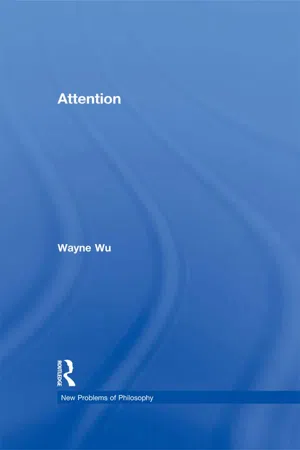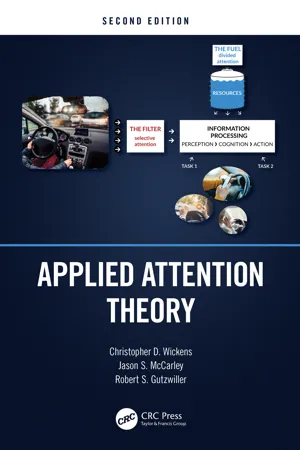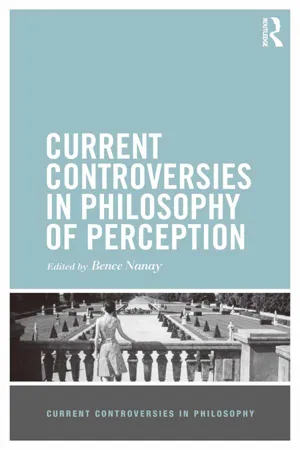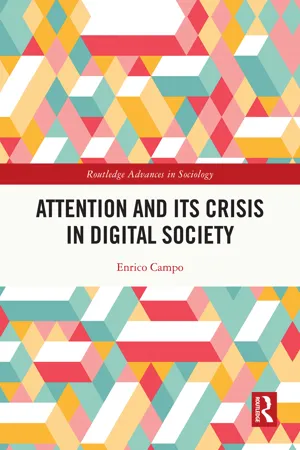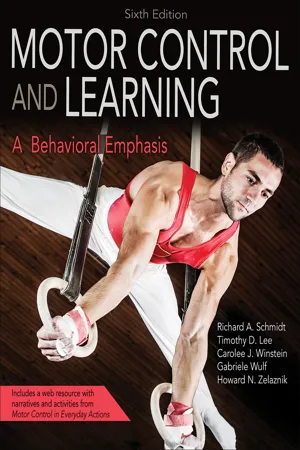Psychology
Inattentional Blindness
Inattentional blindness refers to the phenomenon where individuals fail to perceive a fully visible and often salient stimulus when their attention is focused on another task or stimulus. This occurs because attention is limited, and the brain may filter out information that is not deemed relevant to the current task. Inattentional blindness highlights the selective nature of attention and perception.
Written by Perlego with AI-assistance
Related key terms
Related key terms
1 of 4
Related key terms
1 of 3
6 Key excerpts on "Inattentional Blindness"
- The attentional blink can be demonstrated in normal subjects and is characterized by the inability to notice a second stimulus rapidly presented after an initial stimulus, as if after attending to the first, attention then blinks and misses subsequent stimuli within a small temporal window (Martens and Wyble 2010; Dux and Marois 2009). In both cases, it is postulated that the inability to attend to a stimulus implies that the subject is not conscious of the stimulus. 5 We do not have the space to discuss these interesting phenomena, but the criticisms I shall later make of Inattentional Blindness experiments can be applied to these cases as well. This empirical work suggested to many cognitive scientists that the absence of attention to an object is sufficient for the absence of consciousness of that object. In the visual domain, inattention suffices for blindness, i.e., Inattentional Blindness. Perhaps this seems to you to be the right conclusion, but there are two major questions that must be answered before one can understand what the claim is: What is meant by “blindness,” and what conception of attention is in play? 5.5 On blindness What is meant by “blindness” in Hypothesis (GK) ? It can’t just mean the mundane idea of a failure to notice, as when one yells, “Are you blind ?”, at a friend who fails to notice something visually obvious. The Inattentional Blindness paradigms demonstrate blindness in that sense, but such blindness is compatible with actually visually experiencing what one has failed to notice. That is why we think our friend is subject to criticism for his inattention. Such blindness is unfortunately all too common. Accordingly, for the thesis of Inattentional Blindness to be interesting in respect of phenomenal consciousness, “blindness” must be taken literally. But what does this come to? Surprisingly, there is almost no discussion of this in a literature that constantly speaks about blindness
- eBook - ePub
- Christopher D. Wickens, Jason S. McCarley, Robert S. Gutzwiller(Authors)
- 2022(Publication Date)
- CRC Press(Publisher)
Hills, 1980 ), occurs when a lapse of attention causes an observer to overlook an object that is well above sensory threshold. Mack and Rock (1998a), for instance, found that when observers focused their attention intently on an object in their central vision, they often failed to detect an unexpected object in the visual periphery. More surprisingly, when attention was directed to an item in the visual periphery, many observers failed to notice an unexpected object in their central vision, directly where their eyes were fixated. These effects were not simply the result of poor stimulus visibility, as the probes were easily detected when the observers expected them.Looked-but-failed-to-see errors are not fragile laboratory effects but are easy to produce and sometimes startling in their strength (see Simons & Chabris, 1999 for the seminal demonstration). They have been identified as a common cause of traffic crashes (Herslund & Jørgensen, 2003 ; Salmon et al., 2013 ; White & Caird, 2010 ) and implicated as a potential source of human error in other high-stakes contexts. In a study of simulated traffic stops, for example, 33% of the experienced police officers tested, and more than half of the trainees, failed to notice a pistol sitting in plain sight on the passenger’s dashboard (Simons & Schlosser, 2017 ). In a simulated police foot chase, modeled after a real-life incident, almost 25% of participants pursuing a (pretend) criminal suspect ran past a (pretend) assault and battery without noticing, even under daylight conditions. Noticing rates dropped below 50% when participants performed a simultaneous attention-loading task and fell to 35% under nighttime conditions (Chabris et al., 2011 ).Change blindness, another form of visual lapse, occurs when an observer fails to detect an event in their surroundings. Thus, whereas Inattentional Blindness is a failure to notice something here and now, change blindness is a failure to notice that something is different from what it was. For a computer user, this could be a failure to notice that a new message has arrived in a chat box; for a driver looking back to the road after a glance at the radio dial, it might be a failure to notice that a traffic light has changed (Beanland et al., 2017 ; Pringle et al., 2001 ); for a pilot contending with the demands of a busy cockpit, it may be a failure to notice that the light indicating a change of flight mode has turned on (Sarter et al., 2007 ). In a face-to-face conversation, more remarkably, it can even mean that a speaker fails to notice that the person to whom they were speaking has disappeared and been replaced by someone new. In a study by Simons and Levin (1998 - eBook - ePub
- Graham M. Davies, Daniel B. Wright(Authors)
- 2009(Publication Date)
- Psychology Press(Publisher)
Research from the field of Inattentional Blindness has been applied in a variety of domains, from human–computer interaction (Pew, 2004), to defining legal terms in slip-and-fall cases (Campbell, 2006), to the decreases in driving safety that occur when drivers use cell phones (Strayer, Drews, & Johnston, 2003). Most, Scholl, Clifford, and Simons (2005) argued that Inattentional Blindness should be studied in parallel with a related phenomenon: attention capture. Attention capture is the study of what causes people to notice unexpected objects or events, that is, the inverse of Inattentional Blindness. They argue that these two literatures have largely failed to interact, though their research and findings mirror one another, with research from both fields suggesting that attentional goals matter more than other factors in determining whether unexpected events will be noticed.Relevance to eyewitness testimonyOnce again, we suggest another combination of related but non-interacting literatures. Research into Inattentional Blindness, like that into change blindness, could be combined with research into eyewitness testimony, to produce results that could be useful in the legal world. And yet, thus far the application of Inattentional Blindness to eyewitness testimony has been very limited.An exception to this rule is a study conducted by Clifasefi, Takarangi, and Bergman (2006). Adult participants from a community sample were told either that they were drinking alcohol or that they were drinking an alcohol placebo (tonic alone), and this was either true or false (for a total of four conditions). Those participants who were given alcohol were given just enough to reach a blood alcohol level of 0.04 (half the common legal driving limit in the US). Data revealed that they believed what they were told, and that they reported feeling physical and cognitive impairment accordingly. After their drinks, participants were run through a modified version of Simons and Chabris’ (1999) “gorilla” procedure.In this study, just a third of all participants noticed the gorilla amongst the basketball players, but this Inattentional Blindness was made substantially worse by alcohol. The (only mildly) intoxicated participants noticed the gorilla only 18% of the time, relative to 46% of the time for sober participants. Being told that they had received alcohol was not enough to produce the effect, however, as 30% of those who were told they had drunk alcohol noticed the gorilla, compared to 33% of those told they had drunk only tonic. - Bence Nanay(Author)
- 2017(Publication Date)
- Routledge(Publisher)
deafness to the unattended channel. All allowed that the subject remained aware of certain features in that channel, with the debated issue being how much. The assumption was not Inattentional Blindness/deafness but, as I have put it, inattentional agnosia. In this context, a shift from agnosia to blindness, from an impoverished awareness to the complete absence of awareness, is a strong change in theoretical perspective that requires experimental evidence. In the visual domain, the received view is that the Inattentional Blindness paradigms (Mack and Rock 1998) and their ilk that we have discussed provided that shift, and historically that is true. But if my critique is correct, the shift was not theoretically warranted, and indeed a mistake. It goes beyond what earlier attention researchers were inclined to endorse.This point rebounds to the cognitive access version of gatekeeping, for the following inference seems plausible:1. If S is perceptually conscious of X, then S is access conscious of X.2. S is access conscious of X only if S perceptually attends to X.3. Therefore: If S is perceptually conscious of X, then S perceptually attends to X.In this way, the access version of gatekeeping entails the perceptual attention version of gatekeeping. What should our empirical attitude be toward access gatekeeping? I have suggested that our starting position should be inattentional agnosia, and this means accepting provisionally the falsity of (3). Number (2) is plausible, and various theorists hold that perceptual attention makes things accessible (Dehaene, Kerszberg, and Changeux 1998; Prinz 2012). Since (3) is false, by hypothesis, but the argument is valid and (2) is independently plausible, (1) must be false. The bottom line: the appropriate empirical orientation is to deny both versions of gatekeeping. There can be consciousness outside of attention. This is admittedly a controversial claim, but I hope to have shown that there are prima facie grounds to question what has become the received view about the relation between attention and consciousness.- eBook - ePub
- Enrico Campo(Author)
- 2022(Publication Date)
- Routledge(Publisher)
This basically affirms that we possess a mechanism that allows us to “reconstruct” the unity of the object. So what would happen if, for some reason we did not have such a structure at our disposal? We would live in a “unglued” fragmentary world (Dalrymple, Barton, and Kingstone 2013). This is what happens to those suffering from simultanagnosia, a rare neurological disorder that affects the ability to reconstruct objects: caused by a bilateral lesion of the parietal lobe, patients suffering from this disease are only able to see objects individually and cannot perceive two or more objects at the same time. 22 It is certainly very complex to understand the perceptual experience of those who deal with this pathology, yet we too can run into a somewhat similar blindness, in the sense that if we do not focus our attention on objects we can also fail to perceive them. The research discussed above, based on the visual research paradigm, postulates the existence of a parallel stimulus processing system. However, the subject is intentionally looking for something and is therefore oriented toward processing the information necessary for carrying out the task. But what happens in unexpected events? Are they also processed in parallel? The answer is not so simple and it can also be the case that they are not fully perceived. Here we refer to so-called Inattentional Blindness, or the failure to perceive something that is actually present but toward which no attention is paid. This phenomenon was made famous beyond the circle of specialists that study it thanks to an ingenious experiment proposed by Daniel Simon and Christopher Chabris (to try the experiment firsthand see the video URL in the endnotes). 23 The amusing experiment consists of asking subjects to watch a short film showing two teams of three players each passing a basketball to each other. One team wears white shirts and the other black shirts: the passes only occur between players belonging to the same team - eBook - ePub
Motor Control and Learning
A Behavioral Emphasis
- Richard A. Schmidt, Timothy D. Lee, Carolee Winstein, Gabriele Wulf, Howard N. Zelaznik(Authors)
- 2018(Publication Date)
- Human Kinetics(Publisher)
Participants in a change-blindness study are typically shown a series of still photos (or a video) of a scene in which a portion of the visual display disappears or changes significantly over time. Participants in the experiment often miss or fail to see the change (see Rensink, 2002; Simons & Rensink, 2005, for reviews). In one dramatic live demonstration of change blindness, an actor stops a person on the campus of a university to ask directions. While the participant (the person who is providing directions) explains the route to the actor, two people holding a large door walk between them. The actor is then replaced by one of the door carriers, who assumes the role of the lost actor after the door passes. Although the two actors look somewhat alike, they are clearly two different people. Yet nearly half of the participants in the study failed to recognize the change. The change-blindness phenomenon reflects a strong role of memory, and expectation, as to what we attend to and what we become aware of (consciously). Similar to what occurs with the inattentional-blindness effect, top-down processes play a very important role in attention and awareness. Together, the results of experiments on the Stroop effect, the “cocktail party phenomenon,” and inattentional or change blindness illustrate that humans are capable of searching selectively and attending to specific information in the environment. Sometimes this intentional processing facilitates performance by filtering out unwanted information. At other times the process can have adverse consequences if the filtered information becomes important for task performance
Index pages curate the most relevant extracts from our library of academic textbooks. They’ve been created using an in-house natural language model (NLM), each adding context and meaning to key research topics.
Explore more topic indexes
Explore more topic indexes
1 of 6
Explore more topic indexes
1 of 4
